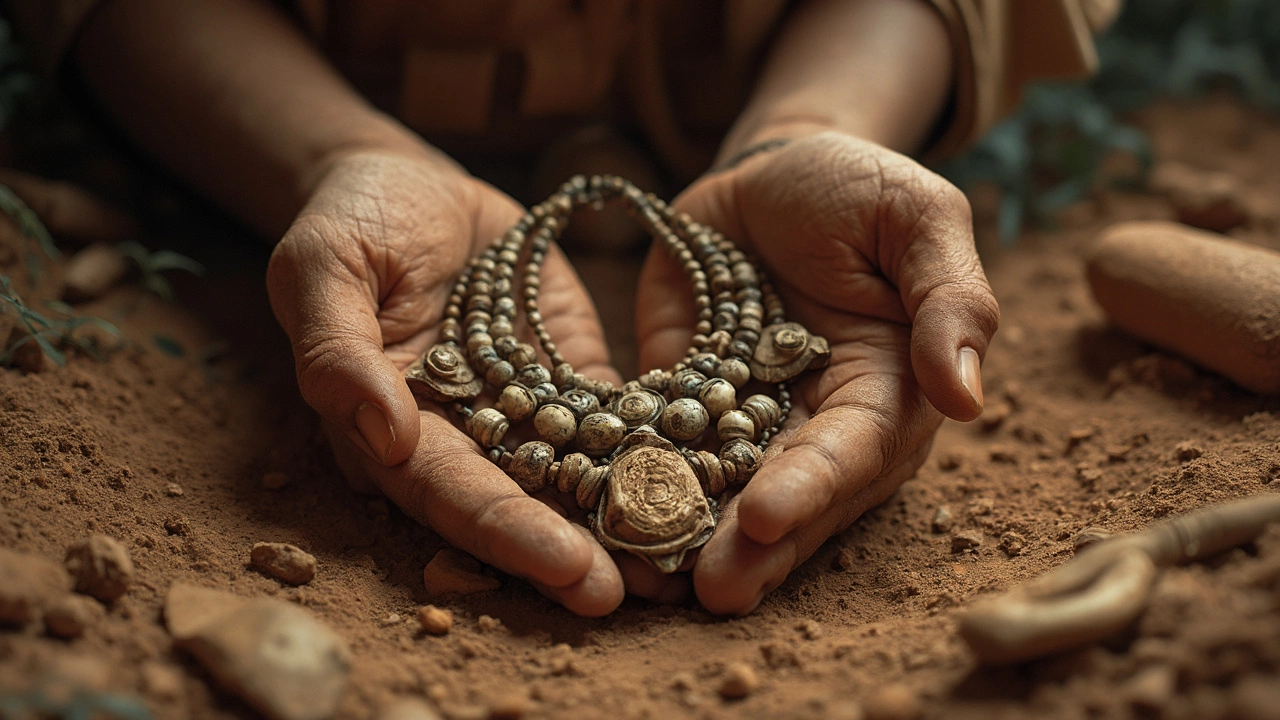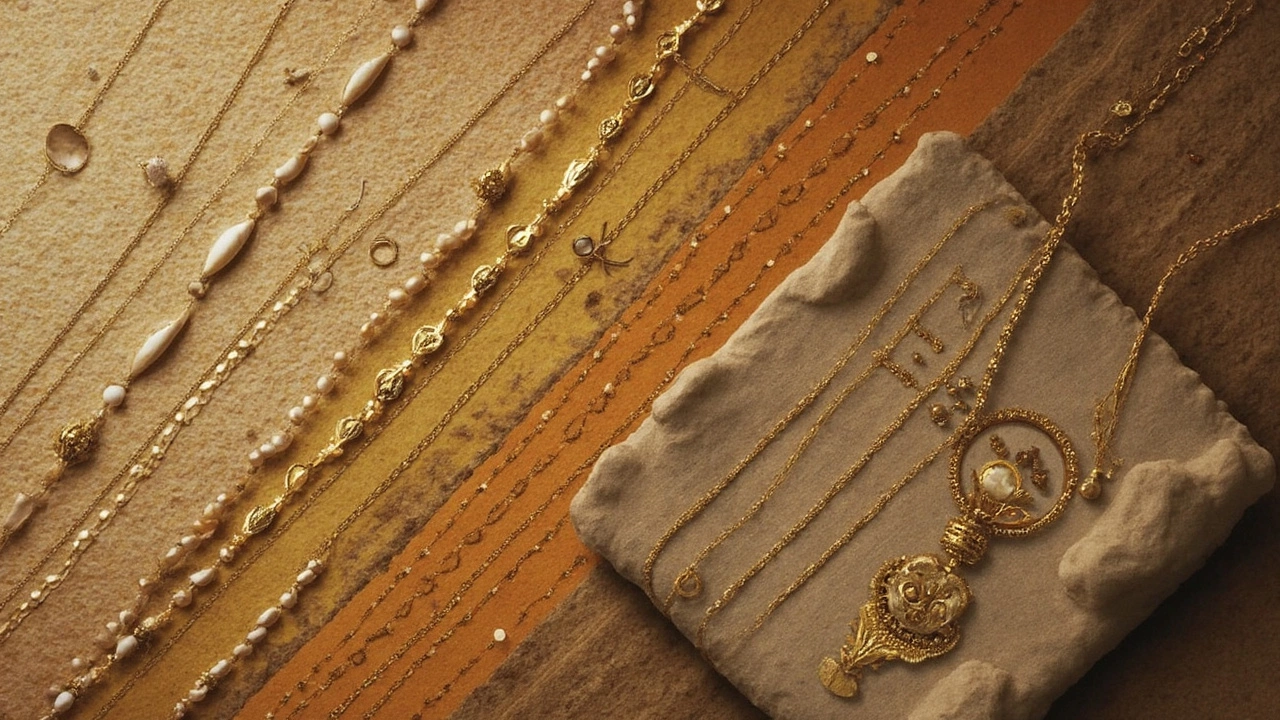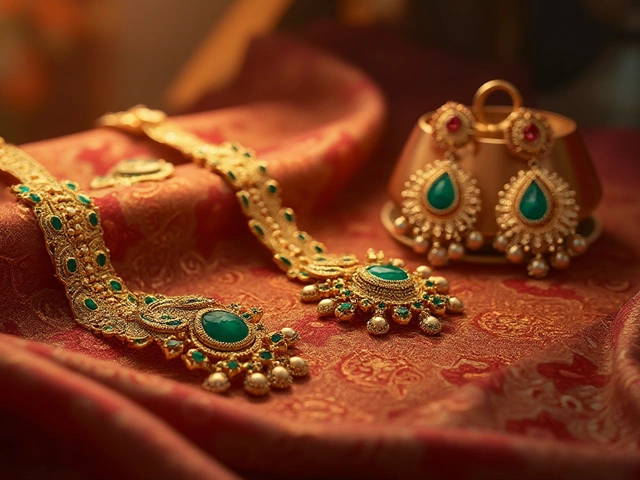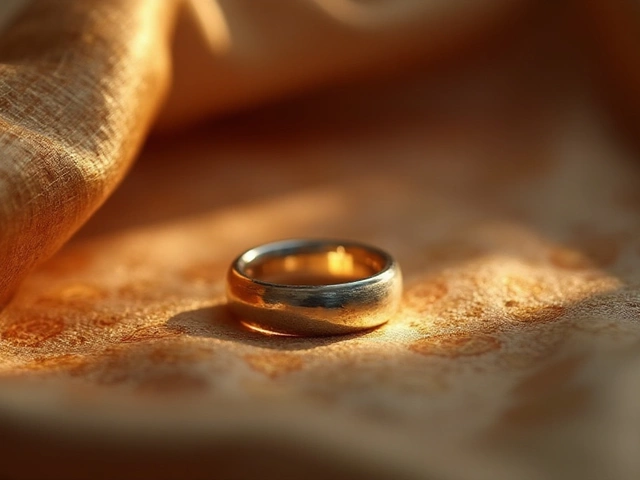
Picture this: You're putting on your favorite necklace, but imagine making it out of snail shells you found in a cave. That's not a weird fashion choice—it's exactly what ancient humans did, way back before written language and farming were even ideas. The oldest jewelry pieces we've ever found are little beads, carved from shells, and they're way older than the pyramids. We're talking 140,000 years old, maybe even older.
People often think bling is all about modern style, but humans have been into personal decoration for as long as we've walked the earth. Those shell necklaces and tiny stone bead bracelets weren't just about looking good. Sometimes, they showed who was part of your group, or maybe gave you a bit of luck, or marked some big deal in your tribe. They couldn't hit the mall, so they got creative with whatever nature handed them.
Finding these ancient beads wasn't easy. Archaeologists have to dig deep into caves in places like Morocco or Israel, and they know what they're looking at thanks to clever tools—basically dating dirt layers or checking snail shell chemicals. When I tell my son Eamon this stuff, he thinks it's like being a treasure hunter, and honestly, he's not far off.
- Cave-Born Sparkle: The Oldest Jewelry Finds
- What Did They Use? Materials and Craft Methods
- Why Even Bother Wearing Jewelry Back Then?
- Digging and Dating: How Scientists Crack the Age
- Tips: Spotting Real Ancient Pieces Today
Cave-Born Sparkle: The Oldest Jewelry Finds
If you ever thought diamonds from grandma were old, get ready to have your mind blown. The world’s oldest jewelry isn’t filed away in a fancy box—it was punched out of sea snail shells by ancient humans way before cities, writing, or even metal tools showed up. In 2021, researchers in Morocco found shell beads at Bizmoune Cave, dating back about 150,000 years. That’s so old, Neanderthals were still around in Europe.
These beads weren’t just pretty—they had holes carefully drilled in, showing someone took time to turn plain snail shells into personal ornaments. Each bead is about the size of a pea. To put things in perspective, these are more than twice as old as the ice age cave paintings at Lascaux in France. And Morocco isn't alone in these discoveries. Other beads from Israel’s Skhul Cave clock in at around 100,000 years old.
Here’s a quick look at some record-breaking finds:
| Site | Country | Type | Estimated Age (years) |
|---|---|---|---|
| Bizmoune Cave | Morocco | Snail Shell Beads | ~150,000 |
| Blombos Cave | South Africa | Nassarius Beads | ~75,000 |
| Skhul Cave | Israel | Shell Beads | ~100,000 |
| Oued Djebbana | Algeria | Shell Beads | ~35,000 |
Experts debate if these beads were currency, status symbols, or maybe even messages. But here’s the thing: no ordinary animal makes jewelry. The fact that early humans bothered to drill, string, and wear beads means jewelry has always mattered way more than just for looks. These finds give us a peek into the minds of our oldest ancestors, showing they wanted to express themselves, connect with their group, or maybe even just stand out.
What Did They Use? Materials and Craft Methods
So, what were the OG jewelry makers working with? Mostly, stuff you'd step on at the beach or find lying around while hiking—think shells, animal teeth, bones, stones, and even a few fancy things like ostrich eggshells. In some of the oldest finds, like those beads from Blombos Cave in South Africa, experts found shell pieces drilled with tiny holes. They even noticed that some shells had signs of rubbing, meaning they were strung as necklaces or sewn onto clothing.
Forget about gold and diamonds—nobody was mining precious metals back then. These early humans worked with what lasted longest and could hold up to a little rough and tumble. One key thing: you see a lot of symmetry, even if the tools were, honestly, pretty basic. They used rocks to grind, shape, or smooth out an object, and probably used plant fibers or leather strips to string beads together.
- Shell beads: Found in Morocco, Israel, and Algeria (over 100,000 years old!)
- Ostrich eggshell beads: Kenya and Tanzania, dating back 40,000 years
- Animal tooth or bone pendants: common all over Ice Age Europe
- Amber: Used in Northern Europe, but much later—still prehistoric though
Replication studies—where researchers try to remake ancient beads—show just how much time and patience this needed. It could take hours just to drill one hole through a hard shell. According to archaeologist Marian Vanhaeren,
"Early bead-makers were incredibly skilled, experimenting with all sorts of materials and creating complex patterns long before metal tools appeared."
Sometimes when you spot oldest jewelry in museums, you’ll notice the style is super consistent. That’s because these folks passed down their craft, probably within families or small groups, for generations. Makes you kinda respect your average cave-dweller’s patience, right?

Why Even Bother Wearing Jewelry Back Then?
Most people figure that ancient folks made jewelry to look cool, but there’s way more to it. Archaeologists have pieced together real reasons behind those early beads and ornaments. These reasons went way beyond vanity—it was about survival, status, and even communication.
First off, back in the day, humans used jewelry as a way to show belonging. If you saw someone with a certain necklace, you’d know they were part of your group. This was huge for cooperation and safety in a world where finding friends (not enemies) made a difference. Some researchers say these beads are like the first social media profile pics—instant signals about who you are.
Second, jewelry worked like natural ID cards. Shell beads or animal teeth were swapped in trade, given as gifts, or worn during special ceremonies. They've found ancient graves where people were buried with a bunch of beads, which wasn’t a coincidence. In the words of Professor Marian Vanhaeren, an expert on early ornaments:
“These artifacts weren’t just pretty—they spoke volumes about social links, identity, even love or loss. Jewelry was a language before there was spoken language.”
Now, think about superstition. People back then believed certain stones, shells, or colors protected them from bad luck or evil spirits. Archaeologists have even found dozens of red-ochre–painted beads in African sites, suggesting folks thought color had real power.
| Reason for Wearing Jewelry | Evidence | Estimated Time Period |
|---|---|---|
| Show group identity | Similar shell beads in different settlements | 140,000+ years ago |
| Trade and exchange | Shells found far from their natural habitat | 100,000 years ago |
| Spiritual protection | Red ochre-painted beads in burial sites | 75,000 years ago |
Take a look at that table. It’s wild to see that even our very distant ancestors used oldest jewelry as more than just decoration. Necklaces or beads told people something about the wearer—where they came from, who they knew, and what they believed. That’s why, even today, the stuff we pick to wear says more about us than we realize.
Digging and Dating: How Scientists Crack the Age
When you hear someone call a bead the "oldest jewelry," it’s not just a wild guess. Figuring out the real age of these pieces is a science project all on its own. Most of these ancient finds don’t come with a tag saying “made in 142,000 BC,” so scientists have to use a mix of cool tools and patient detective work.
First, archaeologists dig up these items in layers of dirt, kind of like a layer cake. The deeper you go, the older stuff gets. But that’s just the start. Here’s what they actually do:
- Radiocarbon dating – For things like bone beads (if they’re not turned to stone), labs can test how much radioactive carbon is left. This helps them put a pretty tight date on anything under about 50,000 years old.
- Optically Stimulated Luminescence (OSL) – Sounds fancy, but it basically tells you the last time dirt was exposed to sunlight. So if a bead’s buried in dirt and you know when the dirt last saw the sun, you know when it got buried. Great for younger finds or stuff without carbon.
- Uranium-series dating – They use this for stuff like caves where beads are found stuck in old mineral crusts. The way uranium breaks down gives you the age of the crust, and that tells you how old the jewelry beneath it is.
- Context clues – It matters what else shows up in that same dirt layer—tools, animal bones, or charcoal. If they know the age of those, they have a good idea about the jewelry too.
These steps come together to build a picture. Take the oldest snail shell beads from Morocco, for example. Researchers dated the cave layers and double-checked with shell chemistry, nailing the age between 142,000 and 150,000 years ago. Honestly, that’s way older than the famous cave paintings in France.
To help you picture the dating methods and some big finds, here's a quick breakdown:
| Site | Country | Estimated Age | Dating Method |
|---|---|---|---|
| Bizmoune Cave | Morocco | 142,000–150,000 years | OSL, Shell Analysis, Context Clues |
| Blombos Cave | South Africa | 75,000 years | OSL, Carbon-14, Context Clues |
| Skhul Cave | Israel | 100,000 years | Uranium-series, Context Clues |
There’s no single trick for pinning down the exact age. Scientists usually use a few different methods for the same site just to be sure. If you ever run across someone selling "ancient" jewelry, don’t just take their word for it. Ask for the dating proof, especially if you're hunting for oldest jewelry pieces for your own collection.

Tips: Spotting Real Ancient Pieces Today
Trying to figure out if a piece of jewelry is actually ancient or just pretending is harder than you might think. Fakes are everywhere now, but you can still spot an authentic oldie if you know what to look for. Here’s what I check when I see a so-called ancient bead or pendant.
- Material matters: Ancient pieces rarely use modern-looking glass or synthetic stones. If you see a piece claiming to be old but looking shiny and factory-made, it’s probably a fake. Most true finds are made of shell, bone, ivory, stone, or old metal types like bronze or copper.
- Look for serious wear: Real old jewelry shows its age—chips, uneven holes, patina, or smoothness from centuries of handling. Even ancient gold isn’t super shiny; it gets dull over time and may have little cracks or pitting.
- Drill holes tell a story: Early humans used sharp bones or rocks to make holes, and those never look perfect. Holes should look slightly uneven or have funnel shapes on one side, not laser-precise like modern ones.
- Check for weird glue or repairs: People started gluing jewelry much later. If you see any synthetic glue or obvious modern repairs, it’s likely a redo, not ancient.
- Ask for a backstory: Reputable sellers can tell you exactly where an item was found and often provide dating info. If they dodge the question or get defensive, that’s a red flag.
Here’s a quick look at typical facts that help you figure out if something is really from ancient times. Real data, not wishful thinking:
| Test/Feature | What to Check | What It Means |
|---|---|---|
| Material Analysis | Shell, stone, bone—not new plastics/metals | Older and more authentic if all-natural |
| Patina | Looks dull, aged, uneven color | Patina means age, can't be faked easily |
| Drill Marks | Rough, off-center, hand-bored holes | Done by hand, not machines |
| Provenance | Comes with details & records | More likely genuine if paperwork checks out |
| Tool Marks | Visible scratch marks from stone tools | Seen in true oldest jewelry pieces |
If you're ever unsure, a quick chat with a certified archaeologist or antique jewelry expert can save you a lot of money and headaches. Better to double-check before shelling out for that 'ancient' necklace at a flea market, right?







